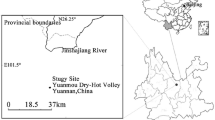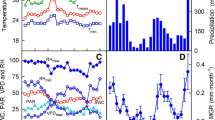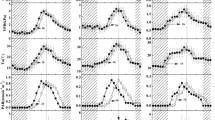Abstract
Key message
Year-round observation suggests that sap flow in growing season represents species-specific transpiration characteristics and sap flow of deciduous broadleaved species in non-growing season is related to daily changes in stem diameter.
Abstract
Year-round observation is necessary to investigate species-specific characteristics of sap flow and its possible contribution in non-growing season. The middle Loess Plateau in China is characterized by temperate climate and vegetation cover of generally drought-tolerant deciduous broadleaved and some evergreen coniferous trees. In this study, Granier-type thermal dissipation probes were applied to measure year-round xylem sap flow in three species from April 2017 to April 2018. Solar radiation, air temperature, relative air humidity, precipitation, and soil moisture were monitored continuously. The results showed that the peak time of sap flux density (Fd) in the diurnal courses of Robinia pseudoacacia was later than that of Quercus liaotungensis and Platycladus orientalis. The peak time of Fd for R. pseudoacacia was significantly postponed during the period with higher soil moisture when compared with that at lower soil moisture, whereas the peak time was reached slightly earlier in the other two species. Sap flow during the non-growing season was relatively higher in P. orientalis than in the two broadleaved species. The diurnal course of Fd in non-growing season showed high values at nighttime and low values in daytime, opposite to that in growing season. Daily variation in stem diameter was inverse of the change in sap flow in the two broadleaved species, whereas the daily change in stem diameter of P. orientalis was very small and showed no clear relation with sap flow. The results suggest that changes in transpiration characteristics with soil moisture conditions vary with tree species; sap flow in deciduous broadleaved trees in non-growing season is small and closely related to daily changes in stem diameter.






Similar content being viewed by others
References
Boyce RL, Lucero SA (1999) Role of roots in winter water relations of Engelmann spruce saplings. Tree Physiol 19:893–898. https://doi.org/10.1093/treephys/19.13.893
Boyce RL, Vostral CB, Friedland AJ (2002) Winter water relations of New England conifers and factors influencing their upper elevational limits II modelling. Tree Physiol 22:801–806. https://doi.org/10.1093/treephys/22.11.801
Breda N, Huc R, Granier A, Dreyer E (2006) Temperate forest trees and stands under severe drought: a review of ecophysiological responses, adaptation processes and long-term consequences. Ann Forest Sci 63:625–644. https://doi.org/10.1051/forest:2006042
Campbell GS, Norman JM (1998) An introduction to environmental biophysics. Springer, New York
Chan AM, Bowling DR (2017) Assessing the thermal dissipation sap flux density method for monitoring cold season water transport in seasonally snow-covered forests. Tree Physiol 37:984–995. https://doi.org/10.1093/treephys/tpx049
Chang XX, Zhao WZ, Zhang ZH, Su YZ (2006) Sap flow and tree conductance of shelter-belt in arid region of China. Agric For Meteorol 138:132–141. https://doi.org/10.1016/j.agrformet.2006.04.003
Chen LX et al (2014) Response of transpiration to rain pulses for two tree species in a semiarid plantation. Int J Biometeorol 58:1569–1581. https://doi.org/10.1007/s00484-013-0761-9
Chen XD, Tang M, Zhang XL, Hamel C, Li W, Sheng M (2018) Why does oriental arborvitae grow better when mixed with black locust: Insight on nutrient cycling? Ecol Evol 8:744–754. https://doi.org/10.1002/ece3.3578
Clearwater MJ, Meinzer FC, Andrade JL, Goldstein G, Holbrook NM (1999) Potential errors in measurement of nonuniform sap flow using heat dissipation probes. Tree Physiol 19:681–687. https://doi.org/10.1093/treephys/19.10.681
Du S, Yamanaka N, Yamamoto F, Otsuki K, Wang SQ, Hou QC (2007) The effect of climate on radial growth of Quercus liaotungensis forest trees in Loess Plateau, China. Dendrochronologia 25:29–36. https://doi.org/10.1016/j.dendro.2007.01.005
Du S, Wang YL, Kume T, Zhang JG, Otsuki K, Yamanaka N, Liu GB (2011) Sapflow characteristics and climatic responses in three forest species in the semiarid Loess Plateau region of China. Agric For Meteorol 151:1–10. https://doi.org/10.1016/j.agrformet.2010.08.011
Fisher JB, Baldocchi DD, Misson L, Dawson TE, Goldstein AH (2007) What the towers don't see at night: nocturnal sap flow in trees and shrubs at two AmeriFlux sites in California. Tree Physiol 27:597–610. https://doi.org/10.1093/treephys/27.4.597
Granier A (1987) Evaluation of transpiration in a Douglas-fir stand by means of sap flow measurements. Tree Physiol 3:309–320. https://doi.org/10.1093/treephys/3.4.309
Granier A, Huc R, Barigah ST (1996) Transpiration of natural rain forest and its dependence on climatic factors. Agric For Meteorol 78:19–29. https://doi.org/10.1016/0168-1923(95)02252-x
Gwenzi W, Veneklaas EJ, Bleby TM, Yunusa IAM, Hinz C (2012) Transpiration and plant water relations of evergreen woody vegetation on a recently constructed artificial ecosystem under seasonally dry conditions in Western Australia. Hydrol Process 26:3281–3292. https://doi.org/10.1002/hyp.8330
He Q-Y et al (2020) Sap flow changes and climatic responses over multiple-year treatment of rainfall exclusion in a sub-humid black locust plantation. For Ecol Manag 457:117730. https://doi.org/10.1016/j.foreco.2019.117730
Holtta T, Linkosalo T, Riikonen A, Sevanto S, Nikinmaa E (2015) An analysis of Granier sap flow method, its sensitivity to heat storage and a new approach to improve its time dynamics. Agric For Meteorol 211:2–12. https://doi.org/10.1016/j.agrformet.2015.05.005
Holtta T, Carrasco M, Salmon Y, Aalto J, Vanhatalo A, Back J, Lintunen A (2018) Water relations in silver birch during springtime: How is sap pressurised? Plant Biol 20:834–847. https://doi.org/10.1111/plb.12838
James SA, Clearwater MJ, Meinzer FC, Goldstein G (2002) Heat dissipation sensors of variable length for the measurement of sap flow in trees with deep sapwood. Tree Physiol 22:277–283. https://doi.org/10.1093/treephys/22.4.277
Jimenez MS, Cermak J, Kucera J, Morales D (1996) Laurel forests in Tenerife, Canary Islands: the annual course of sap flow in Laurus trees and stand. J Hydrol 183:307–321. https://doi.org/10.1016/0022-1694(95)02952-4
Jimenez MS, Morales D, Kucera J, Cermak J (1999) The annual course of transpiration in a laurel forest of Tenerife: estimation with Myrica faya. Phyton-Ann Rei Bot A 39:85–90
Kocher P, Gebauer T, Horna V, Leuschner C (2009) Leaf water status and stem xylem flux in relation to soil drought in five temperate broad-leaved tree species with contrasting water use strategies. Ann Forest Sci 66:101. https://doi.org/10.1051/forest/2008076
Kunert N, Schwendenmann L, Holscher D (2010) Seasonal dynamics of tree sap flux and water use in nine species in Panamanian forest plantations. Agric For Meteorol 150:411–419. https://doi.org/10.1016/j.agrformet.2010.01.006
Lindfors L, Atherton J, Riikonen A, Holtta T (2019) A mechanistic model of winter stem diameter dynamics reveals the time constant of diameter changes and the elastic modulus across tissues and species. Agric For Meteorol 272:20–29. https://doi.org/10.1016/j.agrformet.2019.03.016
Liu ZQ, Yu XX, Jia GD (2019) Water uptake by coniferous and broad-leaved forest in a rocky mountainous area of northern China. Agric For Meteorol 265:381–389. https://doi.org/10.1016/j.agrformet.2018.11.036
Llorens P, Poyatos R, Latron J, Delgado J, Oliveras I, Gallart F (2010) A multi-year study of rainfall and soil water controls on Scots pine transpiration under Mediterranean mountain conditions. Hydrol Process 24:3053–3064. https://doi.org/10.1002/hyp.7720
Lu P, Urban L, Zhao P (2004) Granier's thermal dissipation probe (TDP) method for measuring sap flow in trees: Theory and practice. Acta Bot Sin 46:631–646. https://doi.org/10.3321/j.issn:1672-9072.2004.06.001
Lu WW, Yu XX, Jia GD (2019) Instantaneous and long-term CO2 assimilation of Platycladus orientalis estimated from 13C discrimination. Ecol Indic 104:237–247. https://doi.org/10.1016/j.ecolind.2019.05.007
Ma C, Luo Y, Shao M, Li X, Sun L, Jia X (2017) Environmental controls on sap flow in black locust forest in Loess Plateau. China Sci Rep 7:13160. https://doi.org/10.1038/s41598-017-13532-8
Mantovani D, Veste M, Freese D (2014) Black locust (Robinia pseudoacacia L.) ecophysiological and morphological adaptations to drought and their consequence on biomass production and water-use efficiency. NZ J For Sci 44:29. https://doi.org/10.1186/s40490-014-0029-0
Mantovani D, Veste M, Boehm C, Vignudelli M, Freese D (2015) Spatial and temporal variation of drought impact on black locust (Robinia pseudoacacia L.) water status and growth. iForest 8:743–747. https://doi.org/10.3832/ifor1299-008
Matisons R, Bardulis A, Kanberga-Silina K, Krisans O, Jansons A (2017) Sap flow in xylem of mature Norway spruce: a case study in Northwestern Latvia during the season of 2014–2015. Balt For 23:477–481
Nadal-Sala D, Sabate S, Sanchez-Costa E, Poblador S, Sabater F, Gracia C (2017) Growth and water use performance of four co-occurring riparian tree species in a Mediterranean riparian forest. For Ecol Manage 396:132–142. https://doi.org/10.1016/j.foreco.2017.04.021
Nadezhdina N et al (2010) Trees never rest: the multiple facets of hydraulic redistribution. Ecohydrology 3:431–444. https://doi.org/10.1002/eco.148
Niinemets U, Flexas J, Penuelas J (2011) Evergreens favored by higher responsiveness to increased CO2. Trends Ecol Evol 26:136–142. https://doi.org/10.1016/j.tree.2010.12.012
Oren R, Pataki DE (2001) Transpiration in response to variation in microclimate and soil moisture in Southeastern deciduous forests. Oecologia 127:549–559. https://doi.org/10.1007/s004420000622
Shi WY, Yan MJ, Zhang JG, Guan JH, Du S (2014) Soil CO2 emissions from five different types of land use on the semiarid Loess Plateau of China, with emphasis on the contribution of winter soil respiration. Atmos Environ 88:74–82. https://doi.org/10.1016/j.atmosenv.2014.01.066
Siegert CM, Levia DF (2011) Stomatal conductance and transpiration of co-occurring seedlings with varying shade tolerance. Trees-Struct Funct 25:1091–1102. https://doi.org/10.1007/s00468-011-0584-4
Song X, Yu GR, Liu YF, Sun XM, Lin YM, Wen XF (2006) Seasonal variations and environmental control of water use efficiency in subtropical plantation. Sci China Ser D 49:119–126. https://doi.org/10.1007/s11430-006-8319-X
Tian Q, Taniguchi T, Shi W-Y, Li G, Yamanaka N, Du S (2017) Land-use types and soil chemical properties influence soil microbial communities in the semiarid Loess Plateau region in China. Sci Rep 7:45289. https://doi.org/10.1038/srep45289
Totzke C, Cermak J, Nadezhdina N, Tributsch H (2017) Electrochemical in-situ studies of solar mediated oxygen transport and turnover dynamics in a tree trunk of Tilia cordata. iForest 10:355–361. https://doi.org/10.3832/ifor1681-010
Tsunekawa A, Liu GB, Yamanaka N, Du S (2014) Restoration and development of the degraded loess plateau. Springer, Tokyo, China. https://doi.org/10.1007/978-4-431-54481-4
Wang L, Dai YX, Sun JZ, Wan XC (2017) Differential hydric deficit responses of Robinia pseudoacacia and Platycladus orientalis in pure and mixed stands in northern China and the species interactions under drought. Trees-Struct Funct 31:2011–2021. https://doi.org/10.1007/s00468-017-1605-8
Yan CH, Wang B, Zhang Y, Zhang XN, Takeuchi S, Qiu GY (2018) Responses of sap flow of deciduous and conifer trees to soil drying in a subalpine forest. Forests 9:32. https://doi.org/10.3390/f9010032
Yan MJ, Yamamoto M, Yamanaka N, Yamamoto F, Liu GB, Du S (2013) A comparison of pressure-volume curves with and without rehydration pre-treatment in eight woody species of the semiarid Loess Plateau. Acta Physiol Plant 35:1051–1060. https://doi.org/10.1007/s11738-012-1143-3
Yan MJ, Yamanaka N, Yamamoto F, Du S (2010) Responses of leaf gas exchange, water relations, and water consumption in seedlings of four semiarid tree species to soil drying. Acta Physiol Plant 32:183–189. https://doi.org/10.1007/s11738-009-0397-x
Yan MJ, Zhang JG, He QY, Shi WY, Otsuki K, Yamanaka N, Du S (2016) Sapflow-based stand transpiration in a semiarid natural oak forest on China's Loess Plateau. Forests 7:227. https://doi.org/10.3390/f7100227
Yoshifuji N, Komatsu H, Kumagai T, Tanaka N, Tantasirin C, Suzuki M (2011) Interannual variation in transpiration onset and its predictive indicator for a tropical deciduous forest in northern Thailand based on 8-year sap-flow records. Ecohydrology 4:225–235. https://doi.org/10.1002/eco.219
Zhang JG, Guan JH, Shi WY, Yamanaka N, Du S (2015) Interannual variation in stand transpiration estimated by sap flow measurement in a semi-arid black locust plantation, Loess Plateau, China. Ecohydrology 8:137–147. https://doi.org/10.1002/eco.1495
Zhang ZZ et al (2016) Influence of the decoupling degree on the estimation of canopy stomatal conductance for two broadleaf tree species. Agric For Meteorol 221:230–241. https://doi.org/10.1016/j.agrformet.2016.02.018
Zweifel R, Hasler R (2000) Frost-induced reversible shrinkage of bark of mature subalpine conifers. Agric For Meteorol 102:213–222. https://doi.org/10.1016/s0168-1923(00)00135-0
Acknowledgments
This research was supported by the National Key R&D Program of China (Grant Number 2017YFC0504601) and the National Natural Science Foundation of China (Grant Numbers 41171419, 41471440, 41411140035).
Author information
Authors and Affiliations
Contributions
JL and SD conceived the research. JL, QYH, JY, QWC and RRC conducted the field investigations. JL analyzed the data and wrote the manuscript. All members commented on the data analyses and reviewed the manuscript.
Corresponding author
Additional information
Communicated by Ishii.
Publisher's Note
Springer Nature remains neutral with regard to jurisdictional claims in published maps and institutional affiliations.
Rights and permissions
About this article
Cite this article
Lyu, J., He, QY., Yang, J. et al. Sap flow characteristics in growing and non-growing seasons in three tree species in the semiarid Loess Plateau region of China. Trees 34, 943–955 (2020). https://doi.org/10.1007/s00468-020-01972-1
Received:
Accepted:
Published:
Issue Date:
DOI: https://doi.org/10.1007/s00468-020-01972-1




